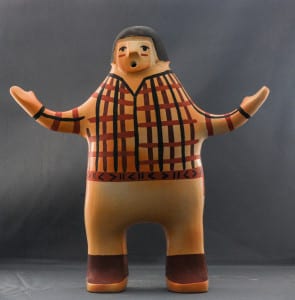An Introduction
This collection began when a 15-year-old boy from Connecticut discovered a dramatic new world in the American West. Climbing mountains in Colorado and the Tetons in Wyoming; camping at Phantom Ranch at the bottom of the Grand Canyon; camping at Hopi; living with a family in their summer hogon at Navajo Mountain… it was the summer that the world became a large and exciting place—and the boy became a man.
This is the archetypal American story: the West formed the American character and provides a place for individuals to prove themselves. In this case, the experience also produced two Hopi pots—souvenirs of the trip. One was intended as a trip gift for the parents who financed the adventure; one was to keep.
Those two pots are the genesis of this collection. The collecting, in turn, has become an excuse to return to Hopi often and come to know Hopi and Tewa-Hopi people, their mesas, and the institutions they have created. I am generally able to visit Hopi at least once a year (and more frequently in good years). With the passage of time and generations, the connections with Connecticut have faded and northern Arizona is now where I go to relax and renew.
Where outsiders see only barren desert, the people who live at Hopi see great beauty. From the most basic elements of this desert –a few shrubs, clay, water, dung, coal and fire– they create pottery that makes this beauty visible to others.
And so those first two pots have become six hundred pots—including seven generations of one family. What started as a few random pots on a shelf has become a collection with its own internal structure, logic, and website. .These pots are linked by material, design, family and culture. I experience the collection as a living being expressing a creative spirit, which I am allowed to sample.
It is a Pahana tradition for outsiders to fall in love with a romantic image of the “peaceful” Hopi and idealize life on the reservation. I know better than that, but the land of the three mesas and the people that call this place home have a special place in my heart. My life and my world would be much impoverished were it not for the experience of that first trip to Hopi and the ensuing dozens of visits back to the reservation. I am certainly an outsider to the Hopi, but over the last six decades I have come to understand something of their rich cultures and have absorbed some of their spirit of gratitude.
Now, sixty-five years after that first trip, it is possible to give back some of the delight and beauty that my connection with Hopi has added to my life. My Native American art collection is being donated to the Museum of Northern Arizona (MNA). They have agreed to absorb almost all of it into their permanent collection and make it especially available to Hopi and Tewa-Hopi people. Meanwhile the Hopivewat Learning Center on Third Mesa is the nexus of the effort to build a professional museum on the Hopi Reservation. When that effort is successful, the MNA will generously loan items from my collection to the Hopi Museum.
Making pottery at Hopi is a spiritual practice; potters do not see their pots as objects but rather as animate objects that participate in their own creation. As the pots in this collection make they way back to Arizona, the MNA, and perhaps to a museum on the reservation, I hope they feel honored and find pleasure returning home.
Access to this collection at both the MNA and a reservation museum will allow Hopi artists to experience the accomplishments of past generations and be inspired. It would be particularly gratifying if the students and teachers of Hopitutuqaiki (The Hopi School) become friends with these pots.
I hope that having the collection available at a museum will encourage non-Hopi people to visit, learn about the people of the three mesas, and be blessed by the experience…
…As I have been.
— C. O.

